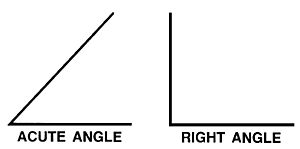Acute angle facts for kids
An acute angle is a type of angle that is smaller than a right angle. You can think of it as a "sharp" or "small" corner. Its size is always between 0 and 90 degrees. Angles are formed when two lines or rays meet at a single point.
Contents
What is an Angle?
An angle is a measure of the space between two lines or rays that meet at a point. This meeting point is called the vertex. The two lines or rays are called the sides or arms of the angle. We measure angles in units called degrees. A full circle has 360 degrees.
Understanding Acute Angles
An acute angle is any angle that measures more than 0 degrees but less than 90 degrees. This means it's smaller than a perfect square corner.
- Examples of acute angles in everyday life:
- A slice of pizza that's smaller than a quarter of the whole pizza.
- The tip of a sharpened pencil.
- The angle formed by the hands of a clock at 1 o'clock or 2 o'clock.
Acute, Right, and Obtuse Angles
Angles are often grouped into different types based on their size:
Right Angles
A right angle measures exactly 90 degrees. It looks like a perfect square corner. You can see right angles in the corners of a book, a window frame, or a wall.
Obtuse Angles
An obtuse angle is larger than a right angle. It measures more than 90 degrees but less than 180 degrees. Think of it as a wide-open angle. The original text mentions that obtuse angles can be from 90 degrees to 180 degrees.
Straight Angles
A straight angle measures exactly 180 degrees. It forms a straight line.
Reflex Angles
A reflex angle is larger than a straight angle. It measures more than 180 degrees but less than 360 degrees.
Measuring Angles
To measure an angle, you can use a tool called a protractor. A protractor is usually a half-circle or full-circle tool with degree markings. You place the center of the protractor on the vertex of the angle and align one side of the angle with the 0-degree mark. Then, you read the degree where the other side of the angle crosses the protractor's scale.
See Also
Images for kids



